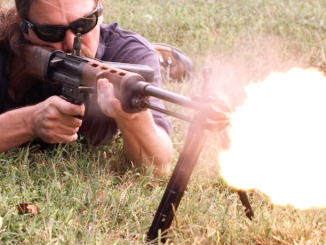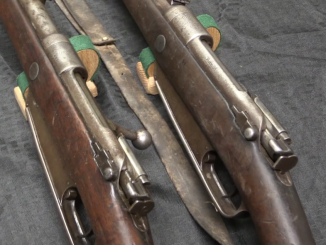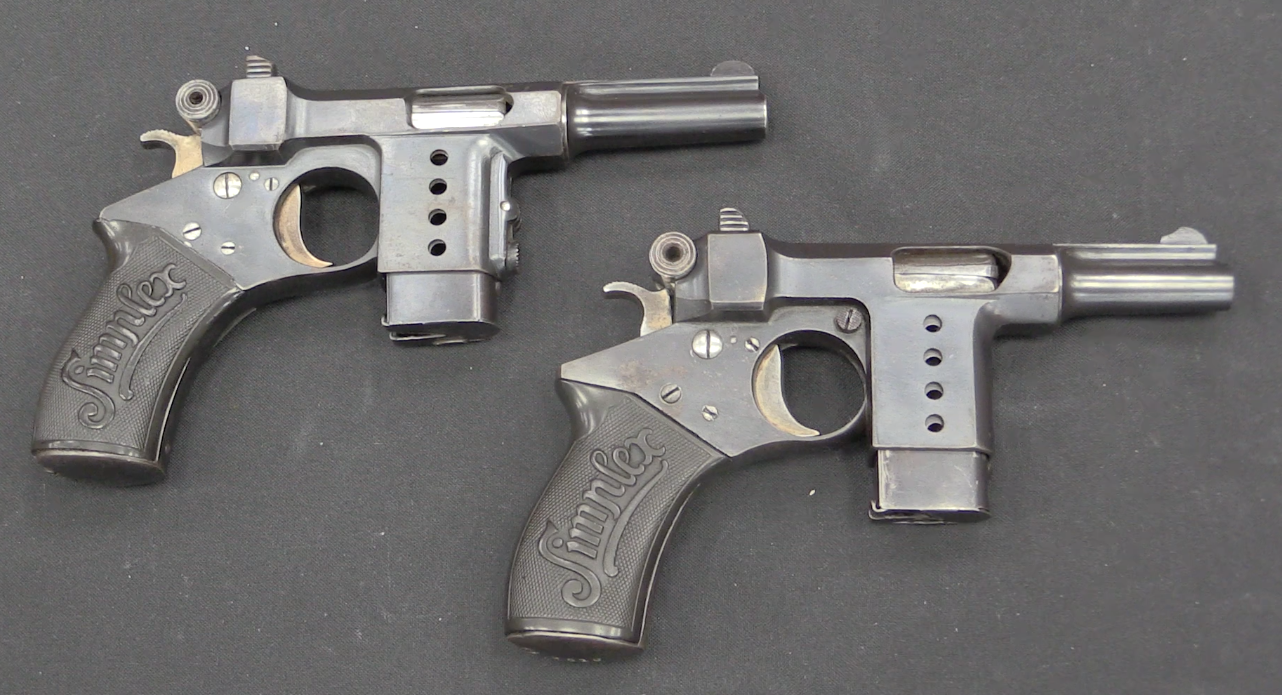In the late 1970s, H&K partnered with Hensoldt to create the ZP/AP (Ziel/Aiming; Projektor/Projector) and then ZPP/APP (Ziel/Aiming; Punkt/Point; Projektor/Projector). This was essentially a calibrated flashlight with an aiming point and pressure switch. It projected a beam of light that was specifically 2m wide at 50m distance, with a black spot in the center which would measure 30cm at 50m. This could be focused and zeroed o the black spot was a functional aiming point, allowing both target identification and engagement. The unit was attached to an H&K claw mount, and would fit any of the standard H&K small arms. Few of the items were imported into the US, as they were bulky, heavy (1.6kg / 2.6 lb) and expensive.
Related Articles

Light MGs
Full-Auto FG-42: An Original 2nd Pattern at the Range
This rifle is being sold by Morphys on October 30, 2018. The FG-42 is a tremendously hyped rifle, but very few people have ever had a chance to actually shoot an original one (including me, […]

Bolt Action Rifles
Rifles of Emperor Menelik II: Ethiopian Gewehr 88 and Karabiner 88
In 1889, Emperor Menelik II ascended to power in Ethiopia, and would rule for 20 years, moving Ethiopia (aka Abyssinia) forward into the modern age. He brought railways, sewer systems, telegraph lines, and other modern […]

Semiauto pistol
Bergmann Simplex Pocket Pistols (Video)
The Bergmann 1896 Number 2 pistol was a relatively successful compact pocket gun for its day, but quickly became obsolete as semiautomatic handguns developed and improved. Bergman and his chief engineer Schmeisser spent the late […]

The correct name is Zielpunktprojektor, written in a single compound word! “Zeilen Punkt Projektor” is incorrect for several reasons.
I didn’t notice a ton of serial numbered parts, so it wouldn’t qualify as “the most German” in my mind.
Also missing the little locking screws!
Good point
Awesome, thank you Ian for finding this stuff and sharing the knowledge.
Beginning from the other side with earlier tech, and delivering effects similar to a bright green laser.
I’d say that you’d have zero problems identifying this as an HK product were you to scrape off any and all identifying marks… Which makes it pretty darn Germanic, in my book.
Of course, the claw mounts are a dead giveaway. The case, and all the included accessories? German. Utterly German.
That’s one of the key things about Germanic weapons, if you’re looking for identifying characteristics: The fulsome accessorization of it all. It’s like “How do you tell it’s German, without anything saying “German” on it…?” Look for all the additional tools, parts, and other items. Good God, even if you go back and look at the old-school stuff like wheellock pistols, the German/Austrian ones all had these cute little accessory kits either built into them, or included somewhere else in the kit. You don’t find that everywhere else, consistently. German stuff? Oh, hell yes. Other people do it consistently, like the Swiss, but since a lot of them speak German, you have to say that there’s something about the language/culture that encourages this.
Contrast that with the US, where if you go looking at things, you’ll find scads of places where instead of designing and issuing a specific specialized tool, they just hand out something that was on issue for a previous weapon, or give you a generic tool.
Ever want to see this on display, go look at the difference between the German company-level armorers tool chest, and the American one. If you want gauge blocks for things like magazine serviceability or much of anything else on the M16 series, the manual gives you handy little shop drawings to take over to someone to have fabricated. That’s generally it; otherwise, you’d have a hard time really distinguishing your small arms repair kit from the one they issue the guys down in the motor pool for working on trucks. The German armorer’s kit, for the G3 and other weapons they had back during the Cold War? Oh. My. Gawd. First time I saw one, I was thinking I was looking at a setup for their equivalent of a 3rd Shop, echelons above first-line maintenance. I was not; it was a company-level armorer’s kit, and that lucky bastard could damn near rebuild all of his weapons with the largesse they gave him. I was embarrassed as hell to show their armorer our kit, TBH…
This is a long-standing Germanic cultural trait. If you ever get a chance to compare, look at the sort of thing they include with their trucks, compared to ours. Or, the tool kits that go with actual German-market cars, or the first-aid kits that are mandated. Much more complete, in all regards; one of my medics was marveling at the stuff included in just a basic automotive kit, because there was so much actual trauma treatment material in it. Not every kit is like that, but when the Germans get given their head on these matters, they’re gonna go deep and hard.
It seems only fair (sorry, couldn’t resist).
If you’re referring to the Bundewehr armorer’s kit that serviced the P38, Uzi, G3, MG and flare pistol, I’d pity the poor guy who had to carry it round. IIRC it was awesomely heavy with each item in its own inletted compartment in a massive wooden case.
I got something similar in principle made about 60 years prior to this.
Idea to combine source of light with fire-arms is older than one might think, take for example this Italian fire-arm-lantern http://historypistols.ru/blog/kremnevye-pistolety/italyanskij-pistolet-fonar/ made in dawn of 19th century
Yes but that doesn’t have a dot for a point of aim. Refer to my handle. I only know of two that still exist and mine is the only one made for the US market.
Projecting light with dark spot where bullet should go? This sound like reincarnation of early 20-th century “Wespi” searchlight sight https://www.gutenberg.org/files/41535/41535-h/41535-h.htm describe it as follows
For years means have been sought to make successful shooting at night possible. White and phosphorescent paints have been applied to the sights and to the top of the barrel but all such methods have proved more or less unsatisfactory even in dim light and in total darkness the target or other object cannot be seen. A recently invented device that overcomes all these difficulties and makes shooting at night practicable is the “Wespi” searchlight sight.
This sight is a tube about 6 inches long and ¾ inches in diameter containing a miniature electric searchlight which projects a dark spot in the center of the illuminated field. When properly mounted on the piece the black spot indicates where the bullet will strike. This sight can be readily attached to any pistol or revolver. As offered on the market at the present time it is adapted for short range work up to, say, 60 feet. The illustrations show a section through the sight tube, and the sight attached to a revolver. The weight is six ounces. (See 61 and 62 facing p. 64.)
This sight embodies the principles of the telescopic sight and can undoubtedly be modified to increase its illuminating power and adapted so as to project well-defined dark lines[Pg 66] similar to cross wires, on a target; or the dark spot decreased in size to about 3 or 4 inches in diameter at 60 feet. So modified this would be a practical sight for target shooting and would be a boon to many of the older marksmen whose sight is failing and who find it more and more difficult to shoot in artificial light with the ordinary sights.
Such a sight would also possess many advantages for beginners as the moving spot on the target would indicate the unsteadiness of the holding and impress upon the marksman the importance of holding the spot in the right position at the instant of discharge. A further improvement would be to substitute for the dark spot, a spot of intensely bright light. This would be equally as effective as the dark spot and would greatly increase the range at which the sight could be used, adapting it to game shooting at night. It is hoped that the manufacturers will develop a sight as suggested for target and game shooting.
British gunmakers include/included a set of tools matched to the individual gun for basic field maintenance and repairs. The Germans were not the only people to provide accessories with their equipment. However, they expected a lot more technical understanding than anyone else.
Why have two moving parts when only a dozen will work just as well. Very German. And that’s why we all love German engineering as much as we like to make sport of it.
Ever tried to reassemble a C96?
C/96 system pistols share an attribute of anything designed by John Moses Browning. That being that when you assemble them, each part only goes in one way- the correct way. (Yes, I’ve done it on C/96s and such.)
I can think of a lot of weapons that don’t share that attribute. My opinions of the M60 GPMG are well known on this subject, so let’s talk about locked-breech weapons that can be assembled and will fire without the breech-locking bits. Such as the Vz58 rifle, or the Type Taisho 14 pistol.
In the pistol you’re not likely to have too much trouble until the frame bolt stop fractures (and you get the bolt in your face), but in the rifle there’s a distinct chance of the breech blowing open on the first shot.
You have to give the designers of the C/96 credit for at least being smart enough to understand why everything should go together “Just One Way”.
cheers
eon
“(…)Ever tried to reassemble a C96?”
96 denotes 1896 year. 1890s were times of pioneers w.r.t. development of automatic pistols. For such situation it is typical for inventor to aim to developed apparatus which is working acceptably well. Refinement comes later. For comparison see British Gabbett-Fairfax Mars. Also to be fair people at Mauser Werke relatively rapidly detected need for simpler automatic pistol in their offer which lead to devising Mauser MOdell 1910 https://modernfirearms.net/en/handguns/handguns-en/germany-semi-automatic-pistols/mauser-1910-14-34-eng/
yes. only a german would go through with the idea of a projector as a sight. queue the jeff goldblaum J. Park gifs/memes
Chuck Norris wanted one of these for the Lebanon raid. Lee Mervin thought the budget better spent on beer and cigarettes so he handed out duct tape and flashlights instead. Good call too, you’d have a hard time hocking one in a North Carolina pawn shop.
The earlier ZP was smaller but was powered by a heavy rechargeable 12 volt battery that required the operator to haul it round in a case with a shoulder strap.
I’ve acquired a number of original HK yellow battery packs for my ZPP’s over the years but being 1970’s or 1980’s vintage and technology they won’t hold charge for more than a few minutes even using the HK marked charging unit. HK folklore is that you should use rechargeable modern C cell batteries or risk blowing the lamp bulb if you use non-rechargeables. I’ve not risked experimenting but either way you have to compress certain types of modern C cell batteries in a vice each by a few mm to get them to fit in the battery compartment. It doesn’t seem to damage the batteries or their functionality and I’d rather break batteries than a ZPP!
Steve…
Bulbs are readily available and eaisly replaceable. Standard is 100lumen. I swapped mine for a 600 lumen and rigged up 2 lithium batteries in a 3d printed holder.. much brighter. 🙂
In fact that was the one Ian had with the trigger activator.
James, thanks for sharing – good to know.
Fun fact: shine a flashlight through a regular rifle scope. You get a bright circle with visible crosshairs. Early night vision devices for hunters used NV goggles and an IR light that was attached to the scope. This kind of setup was legal in some countries, while a real NV sight was not.